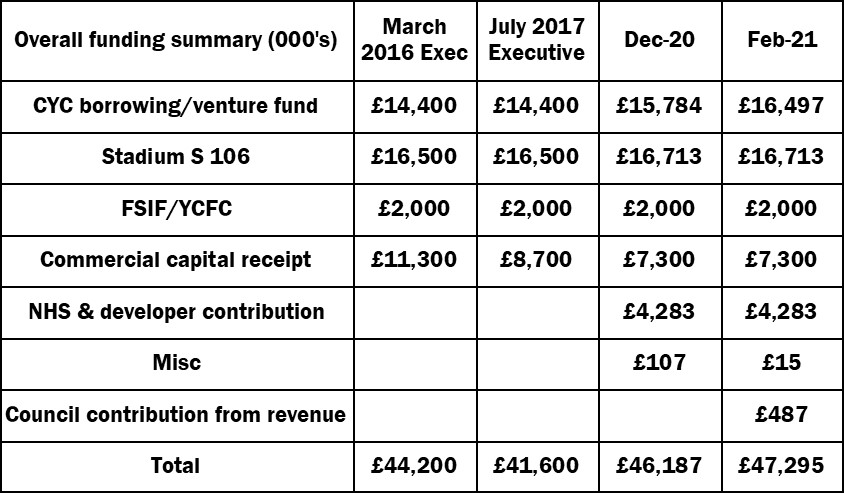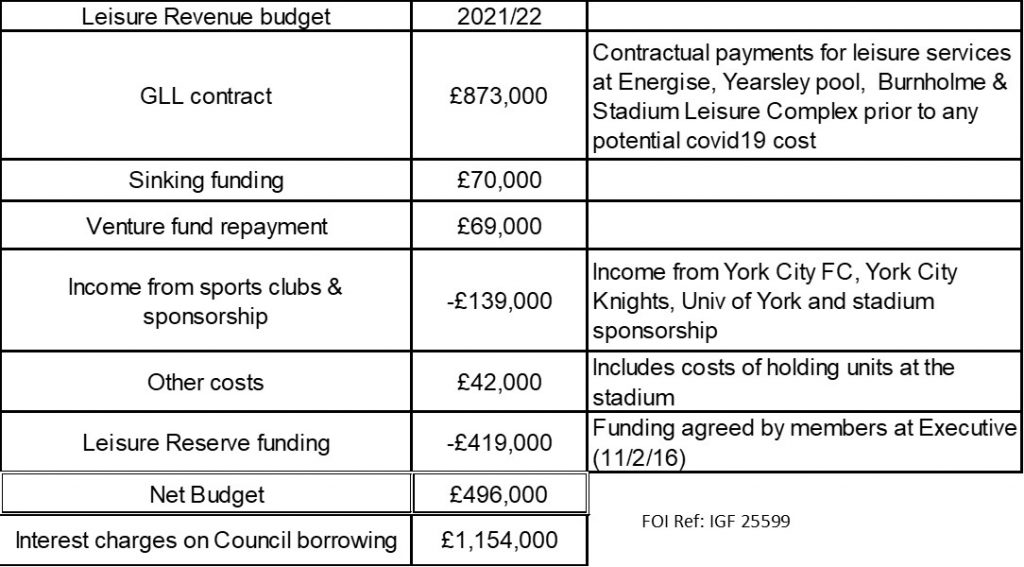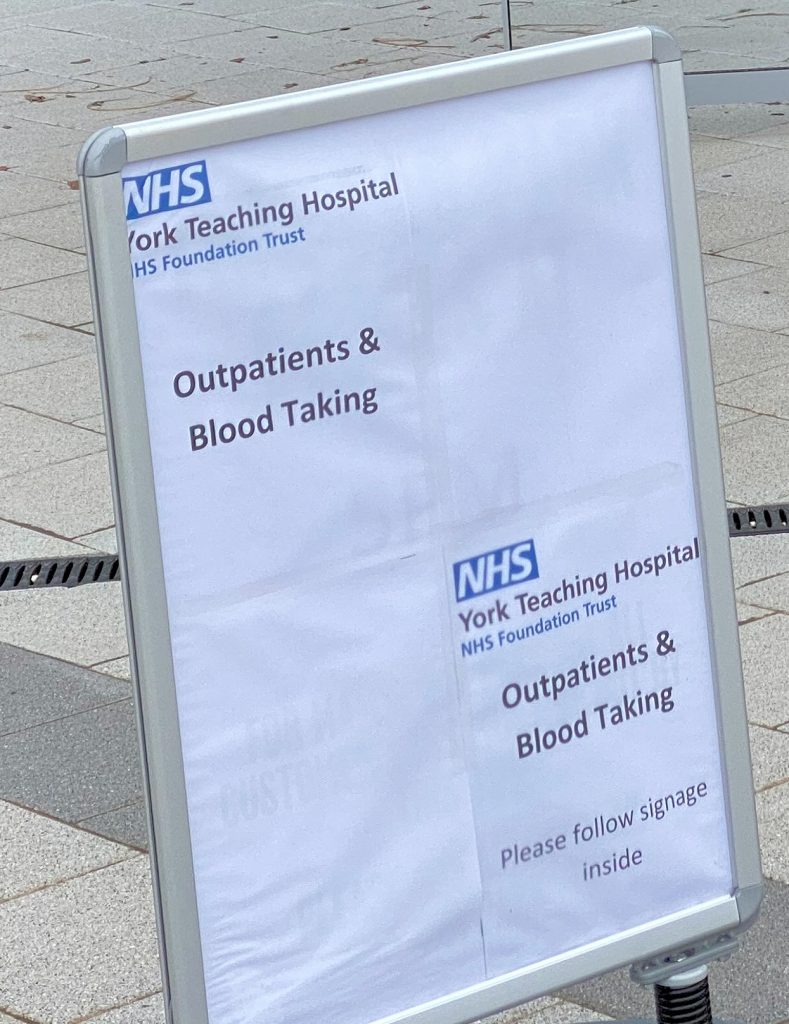Deaths
One death was announced by the York Hospital Trust today. It occurred on Wednesday and was the first Coronavirus related fatality since 17th March
Test Results
Four positive test results have been announced today. They bring the cumulative total up to 12,205
The number of cases in the City has fallen from 64 yesterday to 61 today
The rate /100k population has fallen to 28.96 today. It is likely to fall below 25.0 tomorrow and should remain there for the following few days at least.
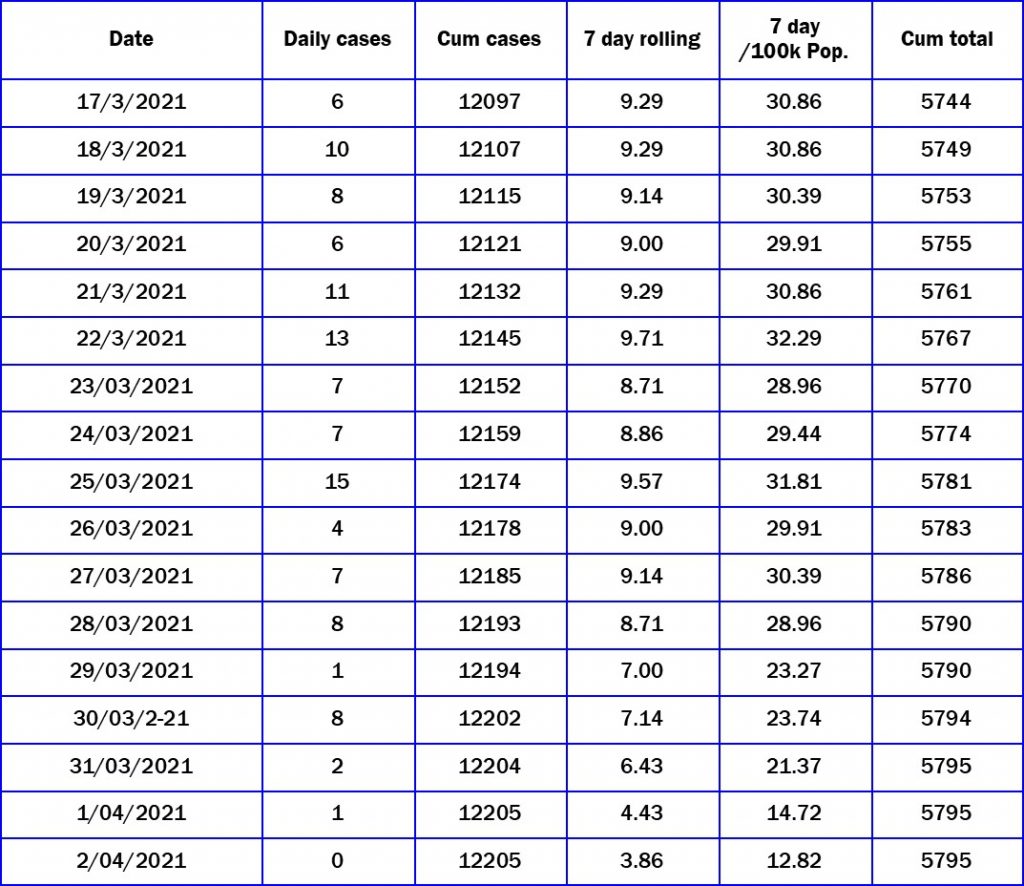
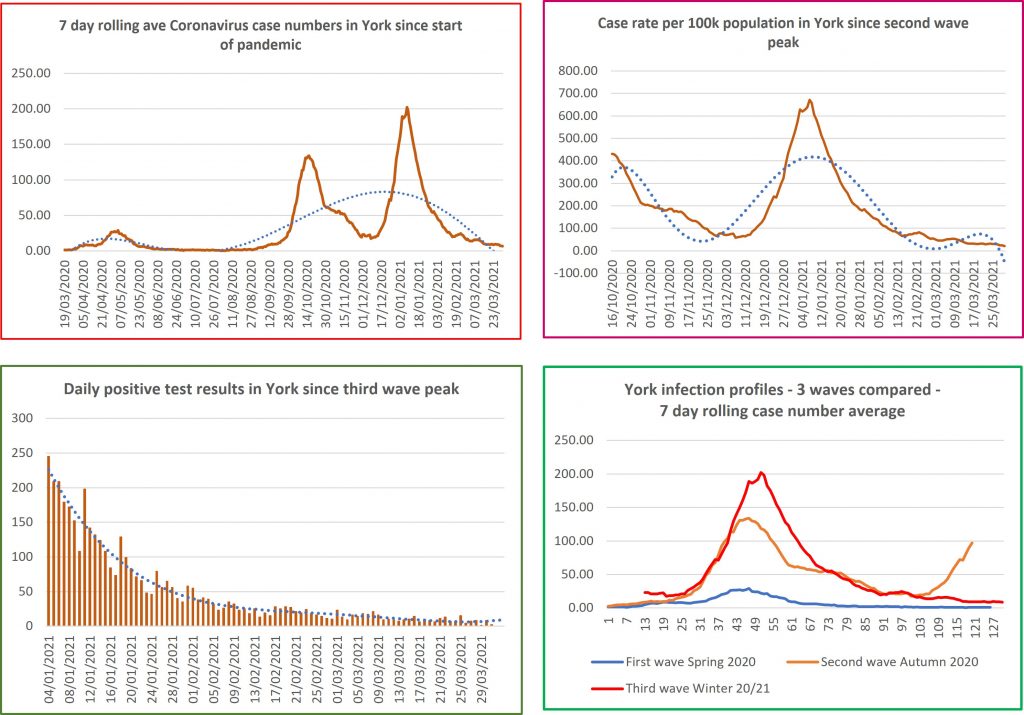
There has been a fall in case numbers in North Yorkshire today and the small but steady decline at regional level is being sustained.
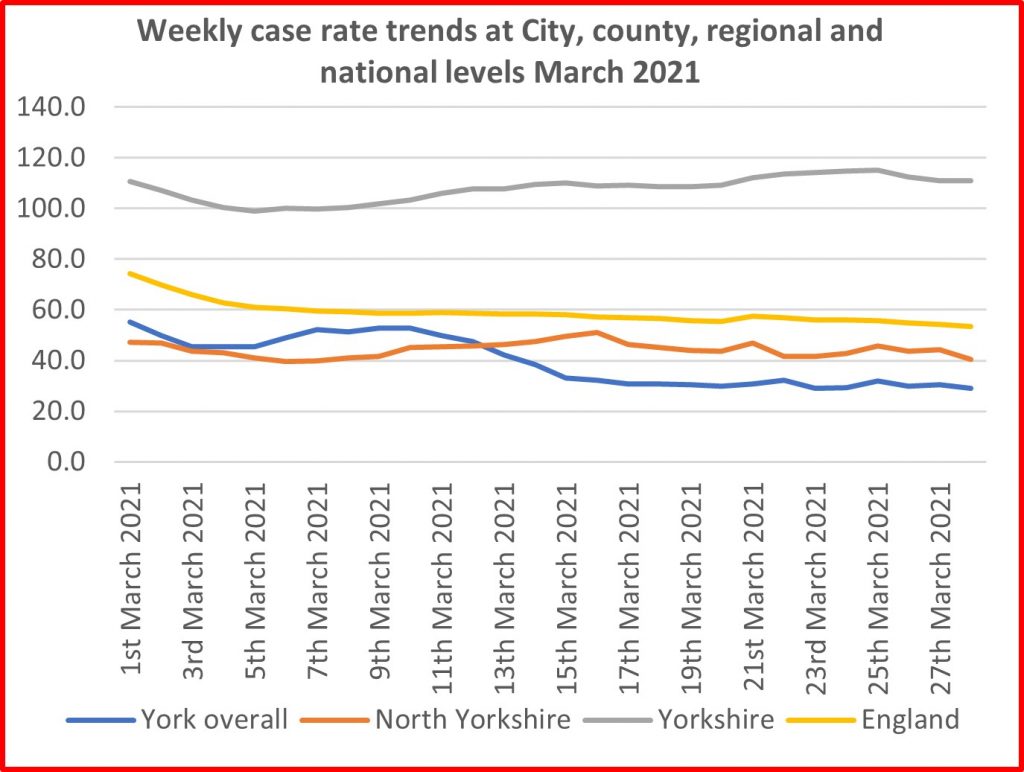
Neighbourhoods
Most neighbourhoods continue to have fewer than 3 cases.
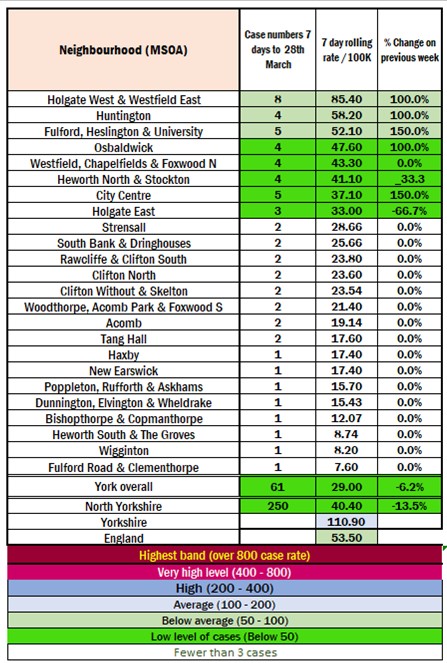
Vaccinations
The vaccination programme is continuing over Easter. The Askham Bar site was busy earlier today

Tests
4406 PCR tests were carried out during the week ending 28th March.
Of these, 1.7% were found to be positive. That is the same proportion as the previous day
2297 “lateral flow” tests were also conducted on 1st April
Council pandemic commentary
The Council has updated is commentary which can be found on open data. It is reproduced below for convenience
The data is accurate as at 8.00 a.m. on Thursday 01.04.21. Some narrative for the data covering the latest period is provided here below:
People with Covid Symptoms
• NHS Pathways/111 triages – as at 28.3.21 there had been 58 total covid triages in the CYC area in the last 7 days. The peak number of triages was 653 in the 7 day period to 20.9.20.
• As at 31.3.21, the Covid Symptom App estimates 41.3 per 100,000 in York with symptomatic covid (responses from a sample of 4,302 people). The peak rate was 1,283 on 7.1.21.
Diagnosed cases
• As at 31.3.21 York has had 12,198 cases since the start of the pandemic, a rate of 5,792 per 100,000 of population. The cumulative rate in York is below the national (6,752) and regional (6,931) averages.
• The PHE ‘Exceedance’ rating compares the no. of new cases over a 14 day period with the previous 6 weeks and provides a RAG rating to indicate if the previously observed trend in the number of new cases is worsening. The latest rating for York (28.3.21) is Red. This is due to a higher than expected number of cases on two occasions: specimen date 22.3.21 (13 cases) and specimen date 25.3.21 (15 cases). In recent weeks the number of cases have been low in York which has an effect on the thresholds used to determine the RAG rating – a small change can mean the difference between a red, amber and green rating.
• The provisional rate of new Covid cases per 100,000 of population for the period 23.3.21 to 29.3.21 in York is 23.3 (using data published on Gov.uk on 31.3.21).
• The latest official “validated” rate of new Covid cases per 100,000 of population for the period 20.3.21 to 26.3.21 was 29.9 The national and regional averages at this date were 54.9 and 112.4 respectively (using data published on Gov.uk on 31.3.21).
• York is currently ranked 29th out of 149 Upper Tier Local Authorities (UTLAs) in England with a rank of 1 indicating the lowest 7 day rate.
• For the 7 day period 19.3.21.to 25.3.21, 1 ward (Strensall) has seen a statistically significant fall in rates compared with the 7 day period 13.3.21 to 18.3.21. 1 ward (Westfield) has seen a significant rise in the rate. The remaining wards have shown no significant change. Ward rates currently vary from 0 to 78.1 per 100,000. 5 wards had zero cases in the latest period.
• The rate of new Covid cases per 100,000 of population for the period 20.3.21 to 26.3.21 for people aged 60+ in York was 24.2. The national and regional averages were 7.9 and 34.8 respectively.
• As at 29.3.21, the latest 7 day positivity rate in York (Pillar 2 PCR tests only) was 0.71%. The national and regional averages are 2.3% and 4.7% respectively.
• As at 29.3.21 the latest 7 day positivity rate in York (Pillar 2 Lateral Flow Tests only) was 0.12%. The national and regional averages are 0.2% and 0.3% respectively.
• As at 29.3.21 the latest 7 day positivity rate in York (Pillar 1 tests only) was 2.1%. The national average is 0.9%.
• As at 31.3.21 York University reported 2 individuals within the University community who were currently self-isolating because they have had a positive COVID-19 test. The peak number was 331 on the 19.10.20.
• As at 29.3.21 York St. John reported 3 individuals within the University community who was currently self-isolating because they have had a positive COVID-19 test. The peak number was 82 on the 8.10.20.
Contact Tracing
• Since 28.5.20 a total of 11,321 confirmed CYC Covid cases have been uploaded into the NHS Test and Trace system and 10,220 of the cases have been completed (90.3%). 26,358 ‘contacts’ have been identified and 19,974 of these have been completed (75.8%). Source: PHE Report.
• Local Tracing of Cases: Between 22.10.20 and 26.3.21, 1,062 referrals had been actioned by the local contact tracing service. Of the referrals actioned, 708 (66.7%) were successful and 354 (33.3%) were unable to be reached via phone or home visit, but guidance leaflets were posted where possible.
Cases in Residential Care Settings
• As at 31.3.21 there were 0 care homes in the CYC area with confirmed Covid-19 infection (at least 1 case of either a staff member or resident).
• The latest ‘outbreak’ (2+ cases) in a residential care setting in York were reported by PHE on 25.2.21 (1 home).
Cases amongst School Aged Children
• In the 7 days up to 29.3.21 there were 6 children of primary and secondary school age who tested positive across 6 schools.
COVID Bed Occupancy in York Hospital
• As at 30.3.21 there were 10 confirmed Covid-19 patients in General and Acute beds. The peak number was 157 on 19.1.21.
• As at 30.3.21 there were 3 confirmed Covid-19 patients and 0 suspected Covid-19 patient in the Intensive Treatment Unit. The peak number for people in ITU was 19 on 10.5.20.
• As at 30.3.21 there had been 0 patients admitted with suspected Covid-19 and 0 with confirmed Covid-19 in the previous 24 hours.
• As at 30.3.21 there had been 3 confirmed patients discharged with COVID-19 in last 24 hours.
• Between 22.3.21 and 28.3.21, 12 CYC residents were discharged from York hospital after needing NHS care for symptoms linked to covid-19 infection.
R Number
• The ‘R’ value (the number of people that one infected person will pass on a virus to, on average) for the North East and Yorkshire area on 26.3.21 was estimated to be in the range 0.8 to 1.0. The previous estimate was (0.7 to 0.9) on 19.3.21.
Total Vaccinations
• As at 30.3.21 a total of 92,113 CYC residents have had the first dose of the vaccine. This represents 43.7% of the estimated total population of York and 52.9% of the estimated adult (18+) population of York.
• As at 30.3.21 a total of 9,857 CYC residents have had both doses of the vaccine. This represents 4.7% of the estimated total population of York and 5.7% of the estimated adult (18+) population of York.
Deaths
The two sources about deaths from Covid-19 at LA level are ONS data and local registrar data. They are derived from the same source (civil registration data). ONS data is more comprehensive as it includes deaths of York residents which have occurred and been registered outside York. Local registrar data is useful as it enables a breakdown by age and gender. The most recently available data is summarised below:
• ONS weekly data: In the most recent period (Week 11: 13.3.21 to 19.3.21) 2 Covid-19 deaths were recorded as having occurred for CYC residents. In weeks 8, 9 and 10 there had been 6, 6 and 3 deaths respectively.
• ONS Cumulative data: Since the start of the pandemic, for deaths occurring up to 19th March 2021 and registered up to 27th March 2021, 386 Covid-19 deaths were recorded as having occurred for CYC residents (226 in hospital, 131 in care homes, 21 at home and 8 in a hospice). The number of deaths per 100,000 of population in York is 183.3 which is lower than the national average of 227.7
• Local Registrar data (Cumulative): Since the start of the pandemic (using data for deaths occurring up to 17.3.21), a cumulative total of 369 deaths of CYC residents where COVID-19 was mentioned (confirmed or suspected) on the death certificate, have been registered. The average age of the people who died was 82.3, with an age range of 44-104. The age profile of those dying in York is older than the national average (79.9% of those who died in York were aged 75+ compared with 73.2% nationally). 178 of the 369 were male (48.2%), less than the national average (54.3%).

